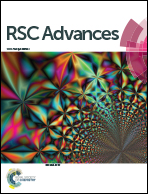Electroanalytical determination of diazepam in tablet and human serum samples using a multiwalled carbon nanotube embedded molecularly imprinted polymer-modified carbon paste electrode
Abstract
In this study molecularly imprinted polymers were grafted on the surface of functionalized multiwalled carbon nanotubes (MWCNTs) using diazepam as template molecules. The MWCNTs–MIP were characterized by Fourier transform-infrared spectroscopy (FT-IR) and scanning electron microscopy (SEM) and then used for modification of a carbon paste electrode (CPE). Cyclic voltammetry (CV) and square wave voltammetry (SWV) methods were applied to study the binding event and electrochemical behavior of diazepam at the modified carbon paste electrodes. The diazepam binding experiments indicated that the sensor modified by MWCNTs–MIP has much higher adsorption ability than the MWCNTs based non-imprinted polymer (MWCNTs–NIP). Under optimized extraction and analysis conditions, the sensor modified by MWCNTs–MIP exhibited excellent sensitivity (4.0 × 107 μA L mol−1) for diazepam with a linear range of 8.0 × 10−9 to 1.0 × 10−6 mol L−1 (R2 = 0.9972) and detection limit of 3.7 × 10−9 mol L−1. The sensor was successfully applied for determination of diazepam in tablets and human serum samples with recovery values in the range of 91.7–100.2%.


 Please wait while we load your content...
Please wait while we load your content...